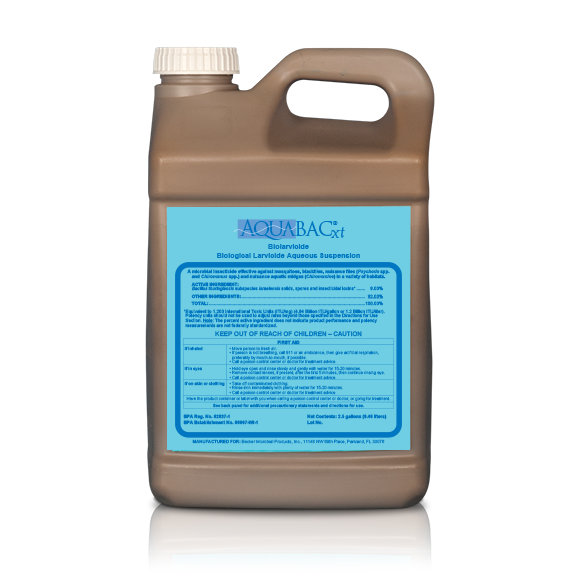Description
AQUABACxt is a highly effective, US EPA-registered biological larvicide. It contains a species of bacteria called bacillus thuringiensis (BT), an approved larvicide for controlling red worms and midge flies in wastewater treatment plants.
Red worms find wastewater plants to be a perfect home. They survive by eating your MLSS, then hatch into midge flies and the cycle repeats. The active ingredient in AQUABACxt kills the red worms and breaks this cycle.
AQUABACxt stands out in the market as it contains 6 complex biological larvicide compounds (called endotoxins) that are highly effective against red worms but safe for fish, birds, mammals, and other lifeforms. With 6 endotoxins, it is difficult for red worms to build a resistance, giving it an advantage over single endotoxin larvicides like Strike™.
Common symptoms of red worm infestations include: disappearing MLSS (the red worms are eating it), stringy or clumpy return activated sludge, and nuisance flies that attract pests. AQUABACxt is safe to use and will only kill a very narrow set of target species; larvae of the mosquito, midge flies, and black flies. It will not cause effluent toxicity issues.
Midge Fly Impact on Wastewater
Midge flies, or chironomids (Chironomidae), commonly occur in wastewater treatment plants and pond systems. The red worm that forms the midge loves the nutrient-rich conditions in a wastewater treatment plant and feeds off bacteria and sludge. The worms will eat mixed liquor and once transformed into adults, clog filters and buildings entrances. Some operators have told us they couldn’t see past their hand in some buildings.
Red worms, also called blood worms, are found in mixed liquor. Over a period of ten days the eggs hatch into red worms and then pass through the pupa stage to become adult midge flies. With no aquatic life to feed on the midges, their life cycle runs uninterrupted, and they multiply fast. If left alone midge flies will cause poor settling, high TSS, and disrupt the bacterial environment. Mixed liquor infested by red worms can see reduced solids, stringy or clumpy sludge, and poor nutrient removal. Not to mention the midge flies are a nuisance that attracts birds and spiders.
*There is no LC50 for aquatic organisms except for mosquito larvae. All other organisms except nuisance flies and midges Psychoda, Chironomus, and Chironomine are not affected by the product. Minnows, fish, Daphnia, and even other aquatic insects can’t be killed by the active ingredient in the formulation. AQUABACxt is specific to mosquito, blackfly, and midge larvae and again is not toxic to anything in the application sites except the larvae of these targets. The LC50 against susceptible mosquito larvae averages 0.15 micrograms per milliliter
Not registered for use in the state of New York.



Steven C. (PA) –
I have been using Aquabacxt in my plant for 5 years. When i took over managing the operations, there was a tremendous amount of Midge flies and larvae in the aeration process. It was an operational nightmare. I started dosing it and within three months, there were no signs of midge flies or the larvae. I just do small weekly maintenance doses now and have not seen a midge fly larvae in years. Definitely an added bonus to your arsenal.
William H. (LA) –
This product works wonders in our Wastewater plant. We can always depend on it to work towards protecting the integrity of our wastewater. It prohibits harmful bacteria from being able to do anything to your water.
Ashley Lynch (GA) –
I discovered Aquafix several years back when searching for a product to get rid of our midge fly larvae infestation. We were so happy with the products price and quality that we haven’t looked elsewhere since. I highly suggest giving Aquafix products a go, as you won’t be disappointed!